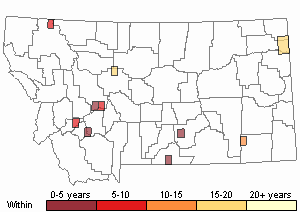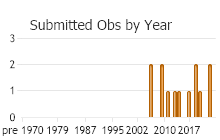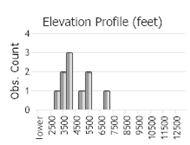View in other NatureServe Network Field Guides
NatureServe
Montana
Utah
Wyoming
Idaho
Wisconsin
British Columbia
South Carolina
Yukon
California
New York
Waved Sphinx Moth - Ceratomia undulosa
General Description
The Waved Sphinx Moth (
Ceratomia undulosa) forewing is variably pale gray to yellowish-brown with a distinct white reniform spot and several dark wavy lines completely crossing wing. The forewing lacks black basal dash (an important distinction). The hindwing is brownish-gray with three darker lines crossing wing, and with a white and dark checkered fringe. The wing span is 76 to 110 mm (Coin 2004).
The larvae's body is usually greenish, sometimes reddish, with 7 pairs of oblique lateral stripes. The lower end of the stripes extend only to intersegmental area, and lack the white granulose spotting. The head has a pink or yellow band running from eyes to crown, and has a pinkish horn. The anal plate is convex above. The anal plate and anal prolegs have conspicuous black spotting (Coin 2004).
Phenology
Both sexes come to lights. The adults fly from May to October in the south, and June to August in the north. There are as many as six peak flight times in Louisiana beginning in early April, repeating at roughly 30 day intervals. Larvae pupate underground, and overwinter in pupa stage. The larvae are present from April to October in the south, and June to October in the north. In the northern portions of its range the Waved Sphinx Moth is single brooded, and in the south there are often two or more broods. Eggs are pale green and medium sized with incubation lasting about eight days (Coin 2004).
Diagnostic Characteristics
Waved Sphinx Moth adults are easily distinguished from the Plebian Sphinx Moth (Paratrea plebeja) by the lack of black basal dash on the forewing. Also, the Waved Sphinx Moth has several wavy lines completely crossing forewing, whereas the Plebian Sphinx Moth has only two lines. The Waved Sphinx Moth larva is similar to the Great Ash Sphinx Moth (Sphinx chersis), but the lower end of the stripes only extend to intersegmental area, and lack the white granulose spotting (Coin 2004).
Range Comments
The Waved Sphinx Moth ranges east of the Rockies in North America, Nova Scotia to Florida, west to Texas and Colorado, north to Alberta, and also is recorded from Oregon and Montana (Coin 2004).
Observations in Montana Natural Heritage Program Database
Number of Observations: 13
(Click on the following maps and charts to see full sized version)
Map Help and Descriptions
Relative Density

Recency



 (Observations spanning multiple months or years are excluded from time charts)
(Observations spanning multiple months or years are excluded from time charts)
Habitat
The Waved Sphinx Moth is one of the most common sphinx moths and prefers deciduous forests, woodlots, tree plantations, shrubby areas, suburban and riparian areas (Coin 2004).
Food Habits
Larvae feed preferentially on leaves of
Fraxinus pennsylvanica (Green Ash) in Canada, but also feed on
Chionanthus (fringetree),
Crataegus (hawthorn),
Syringa (lilac),
Quercus (oak),
Ligustrum (privet hedge), and other woody plants. Adults probably do not feed (Coin 2004).
References
- Web Search Engines for Articles on "Waved Sphinx Moth"
- Additional Sources of Information Related to "Insects"





